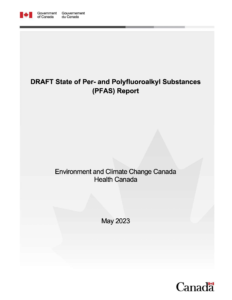
Navigating the PFAS Landscape
February 28, 2024 | By Ian McTeer
Understanding the evolution and potential challenges of forever chemicals in the HVAC/R industry.

(Getty Images)
You may not hear much about this topic during your average workday, but in the grand domain of HVAC/R systems, the pervasive and ubiquitous presence of per- and polyfluoroalkyl substances (PFAS) has become a topic of increasing concern and scrutiny.
This family of synthetic chemicals, which some refer to as forever chemicals, was developed by several companies, 3M being a major pioneer starting production of the compounds back in the 1940’s.
The first major product was perfluorooctanoic acid (PFOA) widely used in non-stick coatings such as Teflon, introduced into the market by DuPont in 1945.
Highly desirable for their water- and grease-resistant properties, PFAS compounds have been instrumental in a variety of industrial applications, including firefighting foams, non-stick cookware, and, notably, as key components in certain HVAC systems.
While their initial incorporation into these systems brought about unparalleled advantages in terms of performance and efficiency, the dark side of PFAS has gradually surfaced. Some members of this chemical family, known for their persistent nature and resistance to degradation, have been identified as posing potential risks to human health and the environment, leading to regulatory actions that have banned or restricted their usage in certain regions.
In 2016, the government of Canada banned the manufacture, use, sale, and import of PFOA, its salts and precursors throughout our country.
As we try to reconcile the complexities surrounding PFAS, it becomes imperative for the HVAC industry to examine these challenges carefully, striking a delicate balance between maintaining the beneficial aspects of these chemicals and safeguarding the well-being of our customers and the ecosystems in which HVAC systems operate.
PFAS compounds are now regarded worldwide as “emerging contaminants” as more information about their toxicity and environmental impact becomes known. Fluorination makes PFAS compounds exceptionally durable and slow to break down and thus are persistent in the environment.
Proposed Toxic Label
 PFAS, or forever chemicals, meet two criteria for being listed as toxic under the Canadian Environmental Protection Act, according to a draft assessment from Environment and Climate Change Canada (ECCC) and Health Canada.
PFAS, or forever chemicals, meet two criteria for being listed as toxic under the Canadian Environmental Protection Act, according to a draft assessment from Environment and Climate Change Canada (ECCC) and Health Canada.
Those criteria include their potential long-term effects on human health and environmental biological diversity.
“To reduce the immediate and long-term harmful effects on human health and the environment, important measures are needed to control the use of PFAS,” Canada’s Health Minister Jean-Yves Duclos said in a statement in May of 2023.
This past spring ECCC published a Risk Management Scope for Per – and Polyfluoroalkyl Substances (PFAS) for a 60-day public comment period. The Heating, Refrigeration and Air Conditioning Institute of Canada (HRAI) assembled a panel of experts to address the government’s Risk Management Scope and submitted a lengthy and comprehensive document detailing Canada’s HVAC/R industry’s desire to base any regulatory outcomes on a weight of the evidence approach using the best available science.
Other groups such as the Chemistry Industry Association of Canada took exception to the proposal in which all PFAS would be treated as an entire class, noting: “It is neither scientifically accurate nor appropriate to regulate as one class,” and, “Canada will not be able to meet climate goals without fluorinated chemistries,” said the association’s policy manager Danielle Morrison.
To date there has not been any indication as to the regulatory route ECCC and HC intend to take, however, ECCC has, no doubt, received numerous and complex briefs from other industries that will be affected as well.
Refrigerants & Components
It should be noted that PFAS compounds represent a diverse and wide-ranging group of synthetic compounds valued for their strength, versatility, and durability.
We are learning about the need to limit or to even prohibit certain PFAS compounds from certain applications; however, many other PFAS composites have well-known properties that do not pose unreasonable risks to human health or the environment when used properly.
The U.S. Environmental Protection Agency (EPA) has developed a working definition of PFAS in which chemicals must have at least two adjacent carbon atoms that are fluorinated, and at least one of those must be fully fluorinated.
The EPA characterization means approximately 6,500 chemicals used throughout North America would fall under their definition.
Even so, the EPA’s definition makes it difficult to determine which substances might fall under any new regulation. The HVAC/R industry depends upon fluorinated gases such as Hydrofluorocarbons (HFC) and Hydrofluoroolefins (HFO) to provide heating, cooling, and refrigeration to meet societal needs that include preserving agricultural produce and dairy products, pharmaceutical cold chains, and human comfort.
Potential PFAS restrictions could include a comprehensive list of currently used pure refrigerants, such as: R-125, R-134a, R-1234ze and R-1234yf, and many others.
Blends such as R-410A, R454B, R-513A, R-448A also fall under the EPA’s definition of PFAS.
R-32, also an HFO, is not on the list as it is outside of the proposed EPA definition, at least for now.
A U.S. industry group, known as the Sustainable PFAS Action Network (SPAN) is a “non-profit organization representing stakeholders that responsibly produce and utilize PFAS compounds in a wide range of commercial products,” according to their website.
 SPAN membership includes: Arkema, Daikin, Honeywell, AHRI, and the Aerospace Industries Association (AIA), among others.
SPAN membership includes: Arkema, Daikin, Honeywell, AHRI, and the Aerospace Industries Association (AIA), among others.
SPAN argues that HFO’s do not show any of several characteristics frequently cited as most concerning when related to PFAS compounds; they are not persistent, bioaccumulative, nor toxic. In fact, SPAN noted EPA’s proposed Toxic Substances Control Act does not include HFO’s.
SPAN advocates for a science-based management policy noting how a blanket restriction that treats all PFAS compounds the same would have devastating economic and safety consequences for our and many other industries.
As there are currently no alternatives to HFO’s, an all-out PFAS ban leaves only the “natural refrigerants” such as CO2, ammonia, and the A3’s left to work with.
The European HVAC/R industry association, EUROVENT, has expressed similar concerns about banning PFAS and fluoropolymer refrigerants, noting, “For those components a time unlimited derogation for both fluoropolymers and non-fluoropolymers should be developed that also reflects the availability of spare parts for repair in the sense of Ecodesign (e.g. is not acceptable to scrap a compressor due to unavailability of an PFAS free O-ring with interchangeable design).”
Fluoropolymers are used in many devices because of their chemical inertness and durability—these are the same characteristics that also make them undesirable.
You are going to find PFAS in a wide variety of components and tools used every day by about everyone, everywhere in our industry. Here is a small sampling: compressor oils and components; air filters: anti-drip additive in flame retardant plastics; coax cables; electronic components – diodes, capacitors, sensors, motors and switches; exterior cabinet paints and coatings; foam cleaning and firefighting agents; heat exchanger tubes – hydrophilic coating (potential); high temperature and/or chemically resistant O-rings/seals/gaskets; lithium-ion batteries – electrode substrate and in the electrolyte; plumber’s tape (PTFE / Teflon); printed circuit board coatings (potential and likely); and pumps (using PFAS O-rings, seals, gaskets).
EUROVENT describes the fundamental importance of PFAS on the properties of air filters, namely the ability to remain durable in high humidity applications along with providing superior dust holding capacity.
Air filters typically contain a PFAS compound known as C6 (PFHxA) providing water and oil repellency. C6 is added to the filter during manufacturing preventing the media from absorbing bonding adhesives that would otherwise plug the air passages and reduce the filter efficacy. There is no alternative to C6 at this time.
In a pathogen-anxious world, the potential loss of air filtration media could leave many people feeling vulnerable, although I would be just as worried about our unfiltered HVAC equipment suffering damage from accumulated contaminants.
What Is The Problem?
Scientists, citing the precautionary principle, are studying the effects of PFAS compounds, especially those that might contribute to developmental defects in fetuses and infants.
Some are suggesting a potential link between certain PFAS compounds and an increased risk of cancer.
PFAS has been shown to accumulate in the liver over time, potentially leading to liver damage, and exposure to PFAS compounds may suppress the immune system; metabolic issues might be caused by PFAS induced thyroid damage; some PFAS exposures are potentially linked to reproductive problems including decreased fertility and hormonal imbalances.
Some scientists, like Professor Miriam Diamond of the University of Toronto Department of Earth Sciences said in a recent interview by CBC’s Marketplace program, “we can’t afford to wait for more studies.”
Governments are studying proposed legislation to ban PFAS chemicals, for example, the European Chemical Agency (ECHA) suggests chemicals and mixtures along with articles (complex goods) having 25 parts per billion (ppb) or more of any particular PFAS compound, or 250 ppb of a combination of PFAS ought to trigger a potential ban. If finalized, the ECHA proposal would be one of the most all-encompassing chemical bans ever enacted.
This kind of proposal puts all PFAS chemicals in the same class despite a hierarchy of significant differences. Certainly, expect a ban on the low hanging fruit such as any PFAS compounds that have immediate alternatives combined with toxic labelling of complex goods and chemical preparations.
There is also no question about restricting manufacturing, use and marketing of products potentially contaminating food or drinking water.
In late November 2023, the 6th U.S. Circuit Court of Appeals dismissed a class action lawsuit against PFAS manufacturers 3M and DuPont. The judge decided the suit filed by the lead plaintiff was too broad and failed to show how the PFAS detected within his body could be linked to the manufacturers.
Such a finding does not mean we can rest on our laurels, certainly more studies are needed so that a solid database of credible facts about any harmful effects to humans and to the environment caused by PFAS can be compiled.
As if the coming transition to A2Ls will not be stressful enough, there is little doubt that every industry could be affected by the PFAS regulatory process.
Businesses may well have to reexamine the composition of their products and potentially institute redesigns free of PFAS fluoropolymer compounds costing untold billions of dollars.
In the meantime, learn more by visiting the SPAN website (span.org) and monitor the Environment Canada and Climate Change website (canada.ca/en/environment-climate-change).
And of course, continue to use personal protective equipment (PPE) when appropriate and dispose of chemicals according to the manufacturer’s instructions and local regulations. <>

 Ian McTeer is an HVAC consultant with over 35 years of experience in the industry. He was most recently a field rep for Trane Canada DSO. McTeer is a refrigeration mechanic and Class 1 Gas technician. Reach Ian at imcteer@outlook.com.
Ian McTeer is an HVAC consultant with over 35 years of experience in the industry. He was most recently a field rep for Trane Canada DSO. McTeer is a refrigeration mechanic and Class 1 Gas technician. Reach Ian at imcteer@outlook.com.


